Introduction to Autism Masking
Autism masking is a nuanced and often misunderstood phenomenon wherein individuals on the autism spectrum consciously or unconsciously camouflage their autistic traits to blend into a neurotypical world. This article explores what autism masking is, why it occurs, the behaviors involved, as well as the mental health implications and societal influences that surround it.
Defining Autism Masking: What Is It and Why Do Autistic Individuals Mask?
What is autism masking?
Autism masking refers to the conscious or unconscious behaviors autistic individuals use to hide or suppress their natural autistic traits. This strategy helps them appear non-autistic and blend into society. Masking techniques can be varied and include mirroring facial expressions, forcing eye contact, adjusting speech tone, suppressing natural stimming behaviors, planning social interactions carefully, and altering appearance to meet social norms.
Why do autistic individuals engage in masking?
Many autistic people mask to gain acceptance and avoid negative social consequences such as prejudice, stigma, bullying, and discrimination. Because society often favors neurotypical behaviors, masking serves as a way to fit into environments that are not designed to accommodate or understand autistic traits. It also helps some individuals hide the discomfort caused by sensory sensitivities or social demands that may feel overwhelming.
In what contexts does masking occur?
Masking can take place in a wide range of settings. It happens in formal environments such as schools, workplaces, and medical settings, where conforming to social expectations is expected. Additionally, it occurs in informal settings — at home with family or among friends — where social norms still influence how comfortable autistic individuals feel being themselves.
By masking, autistic individuals often seek social acceptance and safety, but this effort can be exhausting and may impact their sense of identity and well-being over time.
Common Masking Behaviors and Strategies in Autism
What behaviors are involved in autism masking?
Masking in autism involves a range of behaviors aimed at concealing natural autistic traits to blend in with neurotypical peers. These behaviors can be both conscious and unconscious, often requiring significant effort and mental energy.
Examples of Masking Behaviors
Common masking behaviors include actively mirroring others’ facial expressions and body language to appear more socially typical. Many autistic individuals consciously force themselves to maintain eye contact, even when it causes discomfort or sensory overload. They may also meticulously plan conversations, rehearsing what to say to avoid social missteps.
Another common strategy is altering speech patterns, such as adjusting tone, pitch, or volume to fit expected social norms. This vocal modulation helps them navigate social interactions more smoothly.
Mirroring and Speech Adaptation
Mirroring is a nuanced strategy where autistic individuals copy the nonverbal cues of those around them. This might mean adopting facial expressions, gestures, or posture to reduce feelings of social isolation and improve interpersonal communication.
In terms of speech, changes go beyond word choice and include pacing, prosody, and using social scripts. Such adaptations often require intense concentration and can be mentally exhausting.
Suppressing Stimming and Sensory Responses
To further mask autistic traits, individuals often suppress stimming behaviors, like hand-flapping or rocking, which help regulate sensory input or emotions. Since these behaviors are typically noticeable and misunderstood, hiding them is a common but draining coping mechanism.
Similarly, sensory sensitivities might be subdued or ignored in public settings, leading to additional stress. This suppression can have physical and emotional consequences, contributing to fatigue and mental health challenges.
Overall, these masking strategies allow autistic individuals to navigate various social settings, albeit sometimes at great personal cost. Understanding these behaviors is vital to fostering supportive environments that reduce the necessity of masking.
The Social and Psychological Drivers Behind Masking in Autism
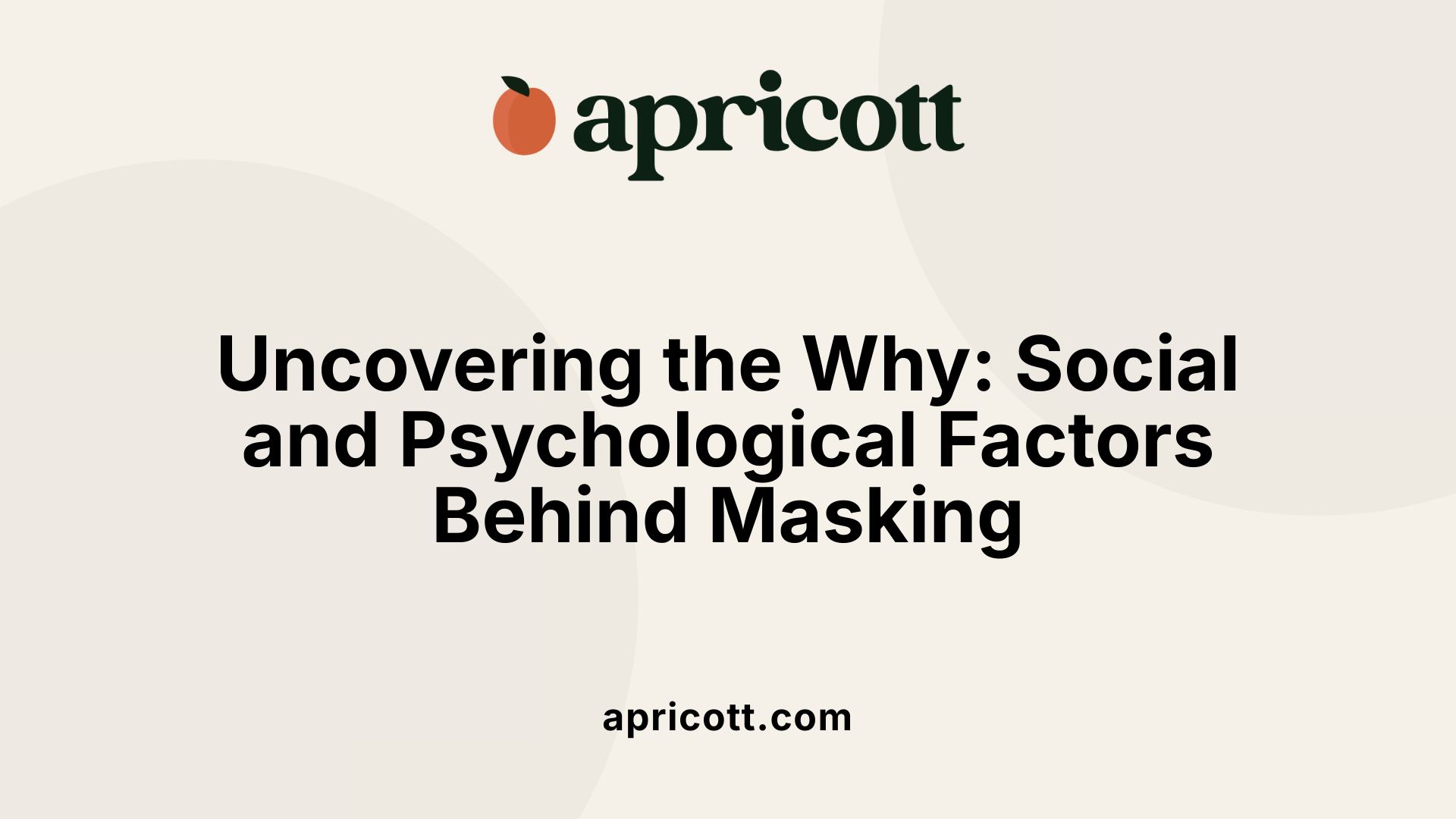
What Drives Autistic Individuals to Mask Their Traits Socially?
Autistic masking is primarily motivated by social factors such as stigma, societal pressures, and the need for acceptance. Autistic individuals often mask to avoid negative judgments, rejection, bullying, or abuse in a society that predominantly values neurotypical norms. Historically, autism has been framed as a deficit that requires correction, which has compounded pressures on autistic people to hide their true selves.
Stigma and Societal Pressure
Stigma surrounding autism fuels masking behaviors. Being autistic can lead to experiences of prejudice, discrimination, and social exclusion, all of which push individuals to camouflage their autistic traits. The fear of dehumanization or marginalization reinforces the urge to adapt to the expectations of a neurotypical world, sometimes through unconscious mechanisms.
Impact of Social Identity and Norms
Social identity plays a crucial role: many autistic individuals feel compelled to "pass" as non-autistic to conform to social norms and gain acceptance. This effort often involves mimicking neurotypical behaviors, suppressing natural responses, and modifying appearance or speech. The influence of these norms is complex, affecting how masking manifests and how exhausting it can be.
Masking as Impression Management
Conceptually, masking functions as a form of impression management where autistic individuals consciously or subconsciously regulate their behaviors to fit in. This aligns with sociological theories that describe how people manage others’ perceptions to navigate social interactions. Masking serves as a survival strategy to minimize the social costs linked to being autistic in environments that are often unaccommodating or hostile.
Throughout these dynamics, masking is not merely a choice but a response shaped by deeply rooted social contexts, often with significant psychological costs for autistic individuals.
The Mental and Physical Toll of Prolonged Masking
Exhaustion and burnout
Prolonged masking involves constant effort to hide autistic traits and emulate neurotypical behaviors. This sustained suppression can lead to severe mental and physical exhaustion. Many autistic individuals report experiencing autistic burnout, a state marked by comprehensive fatigue, reduced tolerance to stimuli, and diminished daily functioning. The energy demands of maintaining a mask are high, often leaving individuals depleted and unable to recover quickly.
Mental health consequences
Masking is linked with a range of adverse mental health outcomes. Autistic people who engage in prolonged masking frequently face increased levels of anxiety, depression, and social stress. The disconnect between their authentic self and the persona they present can contribute to mental health difficulties and in some cases suicidal ideation. Because masking hides symptomatic behaviors, it also complicates or delays diagnosis, meaning necessary support or treatment is postponed.
Loss of identity and self-esteem
A significant consequence of masking is the erosion of one's sense of self. Continuous camouflaging blurs personal identity, leading to an identity crisis, especially for those who have masked for many years before diagnosis. This can lower self-esteem and may increase feelings of social isolation. Masking also heightens vulnerability to emotional and physical abuse, as authentic needs and boundaries are harder to express or defend.
What are the consequences of prolonged masking for autistic people?
Prolonged masking can cause significant exhaustion, autistic burnout, mental health issues such as anxiety and depression, social disconnection, loss of sense of self, low self-esteem, and increased vulnerability to abuse. Understanding these consequences highlights the urgent need for supportive environments that reduce pressure to mask and promote autistic authenticity.
Masking’s Role in Delayed or Missed Autism Diagnosis
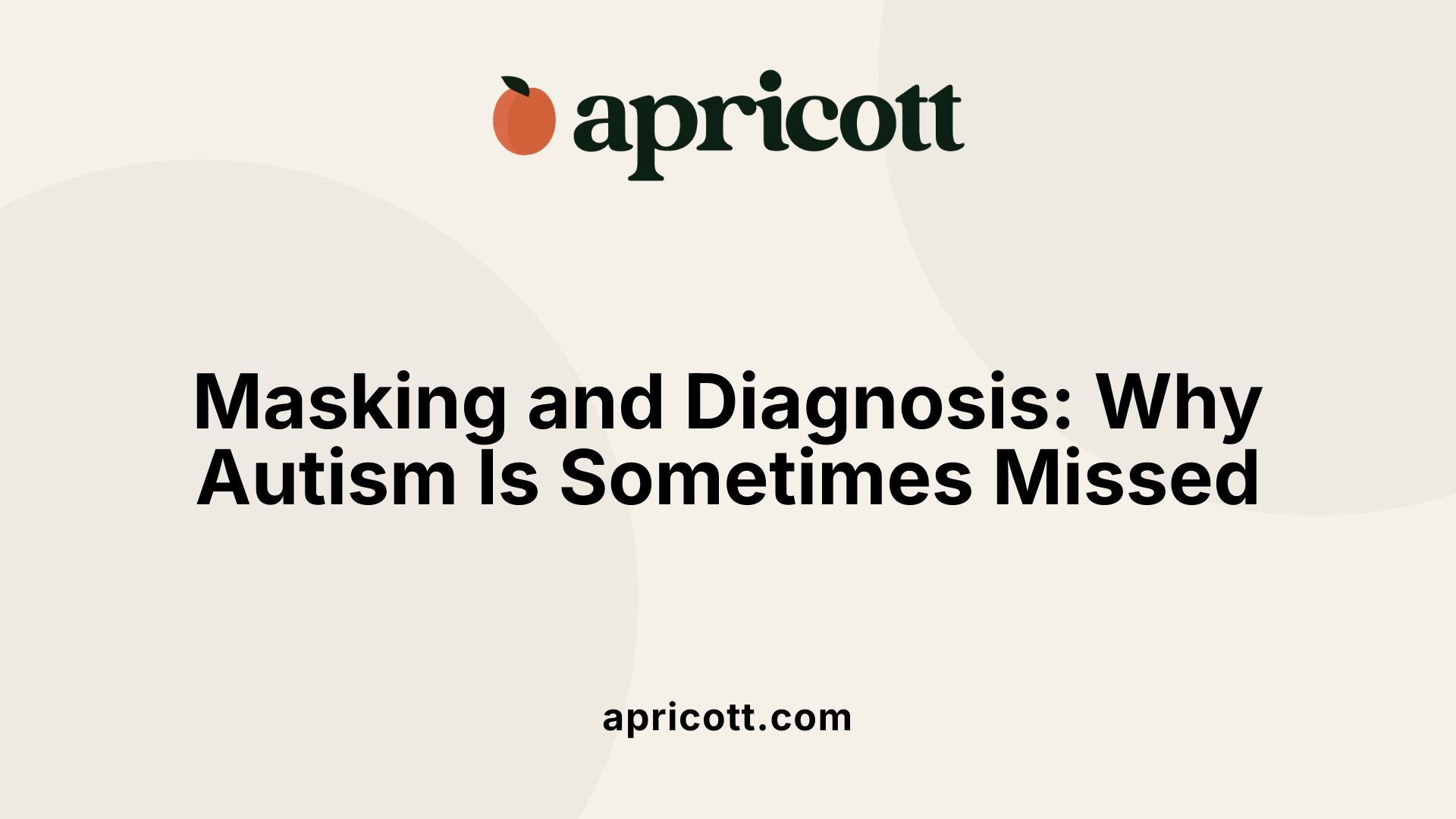
How does masking affect autism diagnosis?
Masking significantly complicates the diagnosis of autism by concealing the typical signs and behaviors that clinicians look for. Individuals who engage in masking suppress or hide autistic traits such as stimming, difficulty with social interactions, or sensory sensitivities. This camouflage of natural behaviors often leads to symptoms being overlooked or misunderstood during assessment.
Especially in females and adults
The challenge of diagnosis is particularly pronounced in females and adults. Females with autism are more likely to use masking strategies to blend into social environments due to societal expectations and gender norms, thereby hiding their autistic traits more effectively than males. Adults who have developed these coping mechanisms since childhood may present without obvious signs, resulting in late or missed diagnoses. This delay can affect access to support and accommodations that could improve quality of life.
Diagnostic criteria and adaptations
Recognizing the impact of masking, diagnostic frameworks like the DSM-5 have adapted their criteria. They now allow for diagnoses even when behaviors are learned or masked later in life, acknowledging that masking is a strategy rather than the absence of autism. This adjustment enables clinicians to consider the possibility of autism despite outward appearances of neurotypical behavior. Tools such as the Camouflaging Autistic Traits Questionnaire (CAT-Q) have also been developed to quantify masking and aid in the diagnostic process.
Gender and Autism Masking: The Female Autism Phenotype
Is autism masking more common in females?
Research indicates that autism masking behaviors are often more prevalent among females. This heightened presence is closely linked to the concept of the "female autism phenotype," which describes how autism may manifest differently in females compared to males. Females with autism are more likely to engage in masking to blend socially, possibly due to stronger societal expectations for women to conform to social norms and to fit in.
The phenomenon is further complicated by diagnostic biases. Traditional diagnostic criteria and stereotypes often focus on male presentations of autism, making it harder for many autistic females to receive early or accurate diagnoses because their masked behaviors conceal symptoms that clinicians expect. This leads to many women masking extensively, especially to succeed in academic and professional settings, often at the cost of considerable mental and emotional strain.
Challenges unique to females include increased mental exhaustion from sustained masking and a higher likelihood of late or missed diagnoses. Women often report masking as cognitively demanding and emotionally taxing, contributing to anxiety, depression, and a conflict with their sense of identity.
Addressing these gender-related complexities requires clinicians and society to recognize varied autism presentations and reduce stigma, allowing women to express their authentic selves without pressure to mask.
Autism Masking Across the Lifespan: From Early Childhood to Adulthood
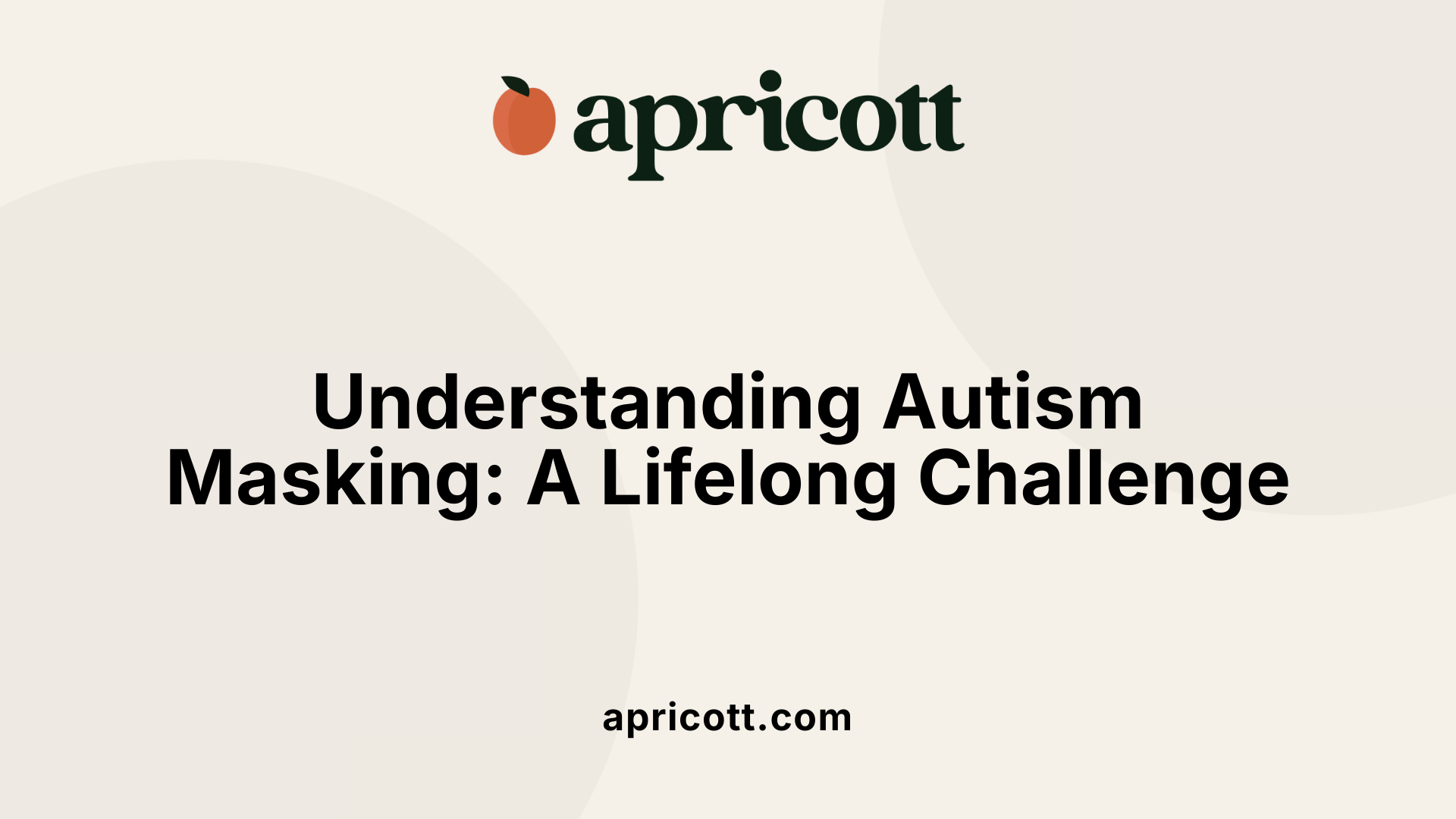
How does masking develop over an autistic person's life?
Masking typically begins in early childhood as an unconscious coping mechanism. Young autistic children may instinctively suppress natural reactions or mimic neurotypical behaviors to reduce social friction or avoid negative attention. This early form of masking often happens without deliberate intent, as children learn from their environment.
As autistic individuals grow older, masking can develop into a more conscious set of behaviors. Adolescence and adulthood often bring increased social expectations and pressure to conform. Many learn deliberate strategies like planning conversations, forcing eye contact, and changing speech tone to appear neurotypical. This conscious adaptation helps them blend into social, educational, and work settings.
For people diagnosed later in life, after years of masking, the process can lead to an identity crisis. Long-term masking may obscure an individual's sense of their authentic self, making it difficult to recognize or accept their autistic identity. Late diagnosis often brings both relief and confusion, as they reconcile their masked persona with their true nature.
These developmental stages highlight the complexity of masking as it transitions from ingrained, unconscious behaviors to intentional strategies shaped by societal demands and personal survival.
| Life Stage | Masking Characteristics | Impact |
|---|---|---|
| Early Childhood | Unconscious suppression of natural autistic behaviors | Reduces immediate social conflict but fosters internal stress |
| Adolescence/Adulthood | Conscious adoption of social mimicry, scripted interactions | Aids social blending but increases exhaustion and identity issues |
| Late Diagnosis | Long-term masking leads to confusion about self and identity | Can cause mental health challenges and delayed support |
Understanding the evolution of masking across the lifespan is essential for providing timely support and fostering environments that encourage autistic authenticity rather than concealment.
Understanding the Complexity: Conscious vs. Unconscious Masking
Is masking always a conscious behavior?
Masking in autistic individuals is not always a conscious choice. It often manifests as an ingrained, sometimes subconscious coping mechanism developed early in life. This unconscious masking means many individuals may not even be fully aware they are suppressing or altering their natural responses to fit social expectations.
How energy-consuming is masking and how does it affect mental health?
Engaging in masking can be extremely energy-draining. Constantly monitoring and modifying behavior to hide autistic traits requires significant mental effort, often leading to exhaustion and what's known as autistic burnout. This sustained stress has strong links to mental health challenges like anxiety, depression, and a loss of personal identity.
How does masking differ from typical social adaptation?
While everyone adjusts behavior to some extent in social situations, autistic masking involves deeper suppression or hiding of core traits across social, sensory, cognitive, and behavioral domains. Unlike typical social adaptation, which is generally flexible and temporary, masking can be a persistent and multifaceted strategy aimed at concealing autism itself. This complexity makes masking a unique phenomenon distinct from general social behavior adjustments.
Masking and Trauma: Exploring Links and Implications
Is there a relationship between autism masking and trauma?
Research indicates a strong correlation between autistic masking and past experiences of interpersonal trauma. Individuals who engage more in masking behaviors often report histories of shaming, teasing about their autistic traits, and various forms of emotional and physical abuse. These traumatic experiences can drive the adoption of masking as a protective or coping mechanism to manage social interactions and avoid further victimization.
Masking as a trauma response
Masking is frequently viewed not just as a social strategy but also as a trauma response. It helps individuals navigate environments that are often hostile or unaccepting toward autistic traits. This adaptive behavior can, however, lead to mental health challenges, such as anxiety and depression, and complicates authentic self-expression. Recognizing masking as a trauma response sheds light on why some autistic individuals mask unconsciously as a survival tactic rooted in earlier negative social experiences.
Therapeutic considerations
Understanding the trauma-masking link urges a reevaluation of certain therapeutic and educational practices. Some therapies, particularly those focused on normalization, may unintentionally encourage masking, potentially exacerbating trauma effects. Providing support that emphasizes acceptance of autistic traits and fosters authentic expression can reduce the reliance on masking, promoting better mental health and well-being. In this context, therapeutic approaches should prioritize safety, validation, and trauma-informed care to address the underlying causes of masking rather than solely its behaviors.
Impact of Community and Acceptance on Masking Behaviors
How does community involvement affect masking in autism?
Participation in the autistic community plays a significant role in reducing masking behaviors. Autistic individuals who engage with supportive community spaces often experience lower levels of masking. This connection is important because it correlates with higher self-esteem and a stronger sense of authenticity.
Being part of a community where autistic traits are accepted and celebrated allows individuals to express themselves without feeling the pressure to hide or change who they are. This lessens the emotional and mental burden masking typically causes.
Supportive environments reducing masking
Creating autism-friendly and understanding environments is crucial to minimizing the need for autistic people to mask. When society fosters acceptance rather than stigma, autistic individuals feel safer and more validated. This can vastly improve mental health outcomes and social experiences.
Support includes recognizing the diversity of autistic expression, offering accommodations, and avoiding the judgment that perpetuates masking.
Benefits of fostering autistic authenticity
Promoting autistic authenticity benefits both individuals and society. It encourages mental well-being by reducing stress, anxiety, and burnout linked to masking. Authentic living enables autistic people to develop a clearer sense of self, improving self-esteem and reducing social disconnection.
Overall, fostering acceptance and community support supports autistic individuals in leading healthier, more fulfilling lives while counteracting the negative consequences of masking.
Supporting Individuals Who Mask: Practical and Therapeutic Approaches
How can we support autistic individuals who engage in masking?
Supporting autistic people who mask involves a combination of societal acceptance, practical techniques, and professional guidance.
Acceptance means fostering environments where neurodiversity is embraced and individuals are not pressured to conceal their authentic selves. Creating autism-friendly spaces reduces the need for masking by accommodating diverse sensory and social needs.
Showing acceptance and understanding
Autistic individuals benefit greatly when others respond with patience and empathy. Avoiding judgment of masking behaviors, whether an individual chooses to mask or unmask, helps reduce stress. Friends, families, and colleagues can support by not taking autistic responses personally and by validating the individual's experiences.
Assistive techniques for managing masking
Practical strategies include helping autistic people prepare social scripts to navigate conversations comfortably and devising alternatives to suppressing stimming behaviors, such as using fidget toys or engaging in activities like knitting. Encouraging gradual unmasking in safe environments promotes authenticity and well-being. Journaling about masking experiences can also foster self-awareness and reduce mental strain.
Role of professionals in support
Psychologists, neurodevelopmental specialists, and behavior analysts play a crucial role in recognizing masking behaviors and guiding individuals towards healthier coping mechanisms. Professional support can help identify internalized ableism or trauma responses linked to masking and promote mental health. Therapy approaches that move away from encouraging masking and instead focus on acceptance and empowerment yield better outcomes.
Together, societal acceptance, individualized support strategies, and professional guidance create a supportive framework for autistic individuals to manage masking's challenges and foster authentic living.
Applied Behavior Analysis (ABA) Therapy and Autism Masking: Intersections and Insights
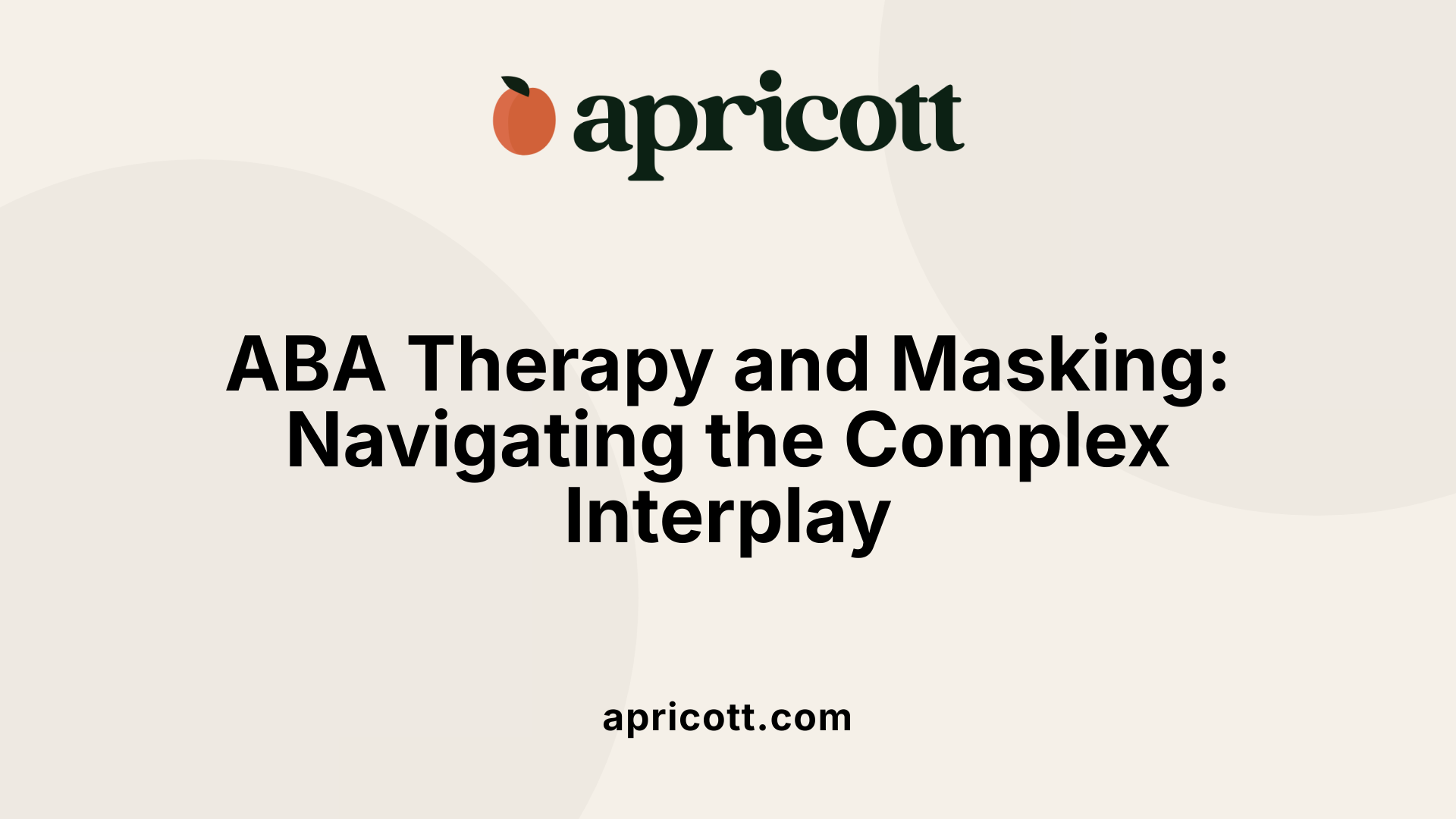
What is Applied Behavior Analysis (ABA) therapy?
Applied Behavior Analysis (ABA) therapy is a scientifically supported approach that uses principles of learning and behavior, such as positive reinforcement, to help individuals with autism improve their abilities and reduce challenging behaviors. Tailored interventions designed through assessments focus on building communication, social, and daily living skills, which aim to empower autistic individuals to engage more successfully in various environments.
How does ABA therapy support individuals with autism?
ABA therapy supports autistic people by systematically increasing desirable behaviors and reducing those that may be harmful or impede independence. Through data-driven and individualized techniques, ABA teaches skills necessary for day-to-day functioning, improving social interaction, communication, and adaptive behaviors. These developments help foster greater participation in family, educational, and community settings.
Who provides ABA therapy and what methods are used?
Typically, ABA therapy is delivered by professionals such as Board Certified Behavior Analysts (BCBAs), Registered Behavior Technicians (RBTs), psychologists, and other trained therapists. Common methods within ABA sessions include:
- Positive reinforcement to encourage desired behaviors
- Discrete trial training breaking skills into small, teachable steps
- Prompting and fading strategies to gradually build independence
- Behavior chaining to link individual skills together
- Extinction and redirection to decrease unwanted behaviors
- Visual supports to aid understanding and routine
- Continuous data monitoring for progress evaluation
Connection to masking and trauma findings
Research has identified links between ABA therapy participation and higher reports of past interpersonal trauma among autistic individuals, suggesting potential associations between some ABA experiences and the development of masking behaviors. Masking—suppressing natural autistic traits to appear neurotypical—may sometimes arise as a coping mechanism in response to social pressures including those possibly reinforced unintentionally during therapy or education.
Therapy’s role in addressing masking
While ABA is valuable for skill development, it is increasingly important to consider the implications of encouraging masking behaviors. Therapy approaches emphasizing acceptance of neurodiversity and supporting autistic authenticity may reduce the need for masking and its related mental health burdens. Professionals can aid by recognizing masking signs, providing supportive environments, and helping individuals express their true selves safely.
By integrating awareness of masking and trauma, autism support can be more compassionate and effective, promoting wellbeing alongside skill acquisition.
Looking Forward: Reducing the Need to Mask through Societal Change
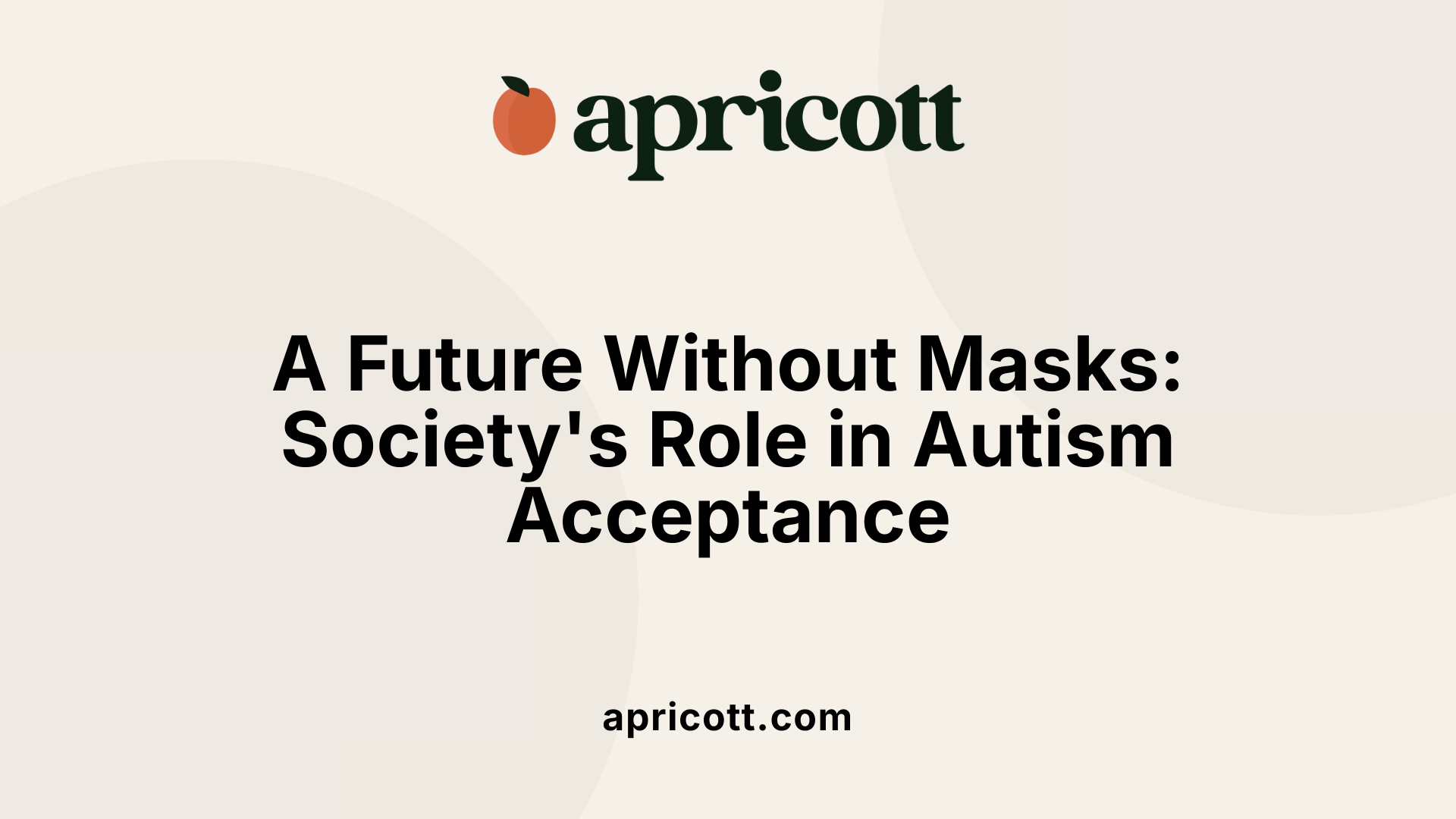
How can society help reduce the need for autism masking?
Reducing the need for autistic masking requires a fundamental shift in societal attitudes toward neurodiversity. Society can help by promoting acceptance of neurodiversity, which means recognizing and valuing autistic traits as part of human variation rather than viewing them as deficits to be corrected. This acceptance creates a culture where autistic individuals feel valued and safe expressing their authentic selves.
Promoting neurodiversity acceptance
Greater public education and awareness initiatives can foster acceptance by dispelling myths and breaking down stereotypes about autism. Encouraging inclusive language and positive representations of autistic people highlights their strengths and challenges without stigma. This cultural change helps to alleviate the pressure to mask in order to be socially accepted.
Reducing stigma and discrimination
Societal efforts to reduce stigma and discrimination are essential. Policies and community programs that protect autistic individuals from bullying, prejudice, and exclusion create safer spaces. Tackling internalized ableism through supportive networks empowers autistic people and validates their experiences without expectation to hide their identities.
Creating accommodating environments
Practical accommodations in schools, workplaces, and public settings reduce environmental discomfort that often triggers masking. This includes sensory-friendly spaces, flexible communication options, and understanding interactions. Autism-friendly environments minimize the demand for autistic people to suppress natural behaviors and adapt to neurotypical norms.
By combining these approaches—embracing neurodiversity, eradicating stigma, and providing supportive environments—society can meaningfully reduce the need for autistic individuals to mask. This leads to improved mental health, greater authenticity, and enhanced inclusion for autistic people.
Conclusion: Toward Understanding and Acceptance
Autism masking is a complex coping mechanism shaped by societal expectations and personal survival strategies. While it can enable short-term social success, the long-term mental health costs are significant. Understanding masking’s causes, behaviors, and consequences—alongside therapeutic insights like those from ABA—and promoting acceptance and accommodations can empower autistic individuals to embrace authenticity. A society that values neurodiversity and reduces stigma will lessen the need to mask, improving well-being for all on the spectrum.
References
- Masking
- A Conceptual Analysis of Autistic Masking: Understanding ...
- Autistic masking
- Autistic Masking in Relation to Mental Health, Interpersonal ...
- Autism Masking Is Common. Here's How To Recognize ...
- “Masking” in Individuals with Autism Spectrum Disorder
- Autistic people and masking
- ABA Techniques: Strategies for Behavior Analysts - GSEP Blog
- Applied Behavior Analysis (ABA)
.svg)
.svg)








